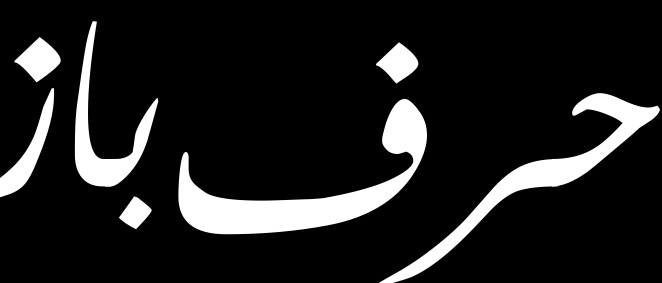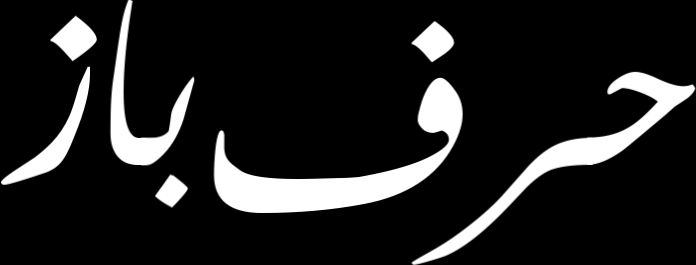This project currently has one script: hb-view.py, a re-implementation of some of the functionalilty of upstream HarfBuzz's C++
based hb-view utilility, with some additional and extra functionality inspired by and taken from hb-shape. It uses pygobject and
HarfBuzz's gobject binding, which is maintained within HarfBuzz.
Specifically, it does ink-box tight-cropping by default, and output PNG images. It also calculates margin adjustments, so that you
can use upstream HarfBuzz's C++ based hb-view utilility to generate vector images with tight-cropping.
Upstream HarfBuzz's C++ based hb-view utilility uses descender/ascender + advance-width , which could be substantially larger or smaller than
the ink area.
For example, for the Persian "HarfBuzz" image below, hb-view.py would output this before generating the PNG image:
default: 693.75 314.375
ink box: 695.25 264.875
margin: -21.25 -1.625 3.75 35.125
You can cut-and-paste this and run C++ hb-view with --margin="-21.25 -1.625 3.75 35.125" to get a vector svg/pdf/ps/eps image of the ink-box area,
if you need a vector image.
There is an option for hb-view.py to use descender/ascender . The drawing code is not a step-by-step translation of C Cairo code to
pycairo Python code, so in both kinds of outputs (ink-box based or descender/ascender+advance-width based), sub-pixel differences are expected.
However, differences should not be beyond fractional pixels.
See below for output demos, and vertical layout for vertical-layout examples, variation selector examples.
All the images are generated by the script, using either libre fonts or fonts from Windows. They should be commonly accessible.
The descender/ascender code depends on a recent bug fix ( harfbuzz/harfbuzz#1209 ) to harfbuzz from me. This was merged after HarfBuzz version 1.9.0 and first appeared in 2.0.0 (released on Oct 18, 2018). Another fix ( harfbuzz/harfbuzz#1363 ) was merged and first appeared in 2.1.2 .
You need to build and install harfbuzz with introspection (./configure --with-gobject --enable-introspection), and have pygobject
(https://wiki.gnome.org/Projects/PyGObject). The latter should be readily available as pre-packaged on many systems.
The drawing code requires freetype-py and pycairo, and uses PIL to display the PNG image.
Highly recommended is pgi-docgen, ( see the HarfBuzz example in pygobject/pgi-docgen#172 ) to generate the HarfBuzz python API reference documentation. API doc generation from gobject doc tool is at best described as both incorrect and incomplete ( https://gitlab.gnome.org/GNOME/gobject-introspection/issues/235 ) .
This comes about from a need for generating figures for the purpose of illustrating /demonstrating complex text layout.
While playing with Sanskrit ligatures in Devanagari (which has hugh ascender/decender and plenty of empty spaces) and also Arabic (which can have strokes outside and clipped by the ascender/decender area), I decided that I don't like C++ ( harfbuzz/harfbuzz#79 ) and thought this kind of tasks should be done by a scripting tool instead of a compiled one.
Sanskrit ligatures use diacritics both above and below the main shape extensively, so have hugh ascender/decenders.
The C++ tool's default (with --background="#000000" --foreground="#FFFFFF" for clarity) shows this, especially with the
default margin of 16:
Here is the ink-box image from the python tool:
On the other hand, Arabic writing can go beyond the area declared by ascender/descenders and advance width.
( --background="#000000" --foreground="#FFFFFF" --margin=0,0,0,0). The uneven margins on the 4 directions
would also be difficult to set manually. Here is the Persian word for "HarfBuzz", note the clipping below and on the left-side:
Here is the ink-box image from the python tool:
More than two years before the Devanagari/Arabic activities, I first encountered harfbuzz/harfbuzz#79 with CJK fonts. When one is generating an image of CJK glyphs, one expect equal margins around the square shapes. I was surprised by the empty space below, though it is understandable that many CJK fonts have Latin glyphs and have a descender area.
Don't forget to checkout the vertical layout images too, and variation selector examples.
The C++ hb-view also has an inconsistency, special-casing ansi output: ansi drawings skips blank ascender/descender areas above and
below the ink-box.



